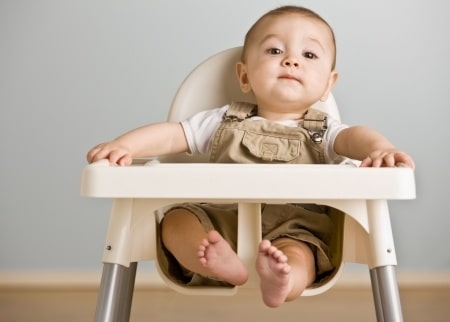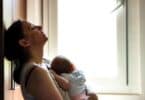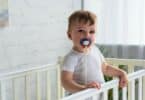As parents, we expect baby products to be safe. Unfortunately, this isn’t always the case (take crib bumpers, for example). Some products are safe, but have manufacturing defects that cause them to be unsafe (as in the case of product recalls). Then there are the products that are generally safe, but only if used properly. Regardless of which category a product falls into, one of the most dangerous assumptions a parent can make is that a product a product is safe enough to leave baby unattended.
Researchers from the Center for Injury Research and Policy, of the Research Institute at Nationwide Children’s Hospital in Ohio, said that most parents assume high chairs and booster seats are safe. However, thousands have been recalled over the last several years. And, if not used properly, a highchair can be extremely dangerous.
“Families may not think about the dangers associated with the use of high chairs,” Dr. Gary Smith, director of the Center of Injury Research and Policy at Nationwide Children’s Hospital, told Medical News Today. “High chairs are typically used in kitchens and dining areas, so when a child falls from the elevated height of the high chair, he is often falling head first onto a hard surface such as tile or wood flooring with considerable force. This can lead to serious injuries.”
So dangerous, in fact, that about one child per hour is treated for a highchair related injury.
Dr. Smith and his colleagues arrived at this conclusion after analyzing the number of highchair related emergency room visits from 2003 to 2010. A total of 9,400 children under the age of three were treated during that time for high-chairs; the average turned out to be about one treated injury per hour.
More specifically, 37% of all injuries were closed head injuries. (It should be noted that this particular injury rose drastically (90%) over the period of the study, going from almost 2,558 in 2003 to 4,789 in 2010.) Around 33% of the children suffered from bumps and/or bruises, 19% suffered from cuts, 59% had injuries on the head and/or neck, and 28% had injuries on the face.
When looking at how the injuries occurred, the team found that most (93%) involved a fall. Two-thirds occurred because the child was either standing on or climbing on the highchair right before the fall happened. Researchers say this suggests that the children either weren’t restrained, or the restraint system failed to work properly.
According to Dr. Smith many parents mistakenly assume the chair tray will keep the child from falling or jumping out of the chair. This is not the case, however, and parents should exercise extra caution – examine the straps regularly and always use the straps when placing the child in the chair, even when sitting right there – to keep children safe during, before, and after feeding times.
“The number one thing parents can do to prevent injuries related to highchairs is to use the safety restraint system in the chair,” Dr. Smith said. “The vast majority of injuries from these products are from falls. Buckling your child in every time you use the high chair can help keep them safe.”
Other precautions parents can take to keep their child safe in a highchair include:
- Never leaving the child unattended in the chair.
- Checking to make sure straps are working effectively and firmly attached to the chair.
- Locking wheels of the chair when in use.
- Making sure the chair is stable.
- Not allowing child to stand in the chair.
- Not allowing the child to climb on or sit on the tray.
- Clearing the surrounding area of anything the child could grab ahold of or knock over (silverware, tablecloths, plates, hot foods and liquids, etc).
- Checking for highchair recalls regularly, and if possible, registering to ensure that notifications are received if a recall does occur.
Related Articles:
- As Technology Advances, Studies Reveal that Babies Know More than Previously Thought
- What is The Age of Appreciation?
- Study: Brain Abnormalities May Be the Reason Behind Some Sudden Infant Deaths







